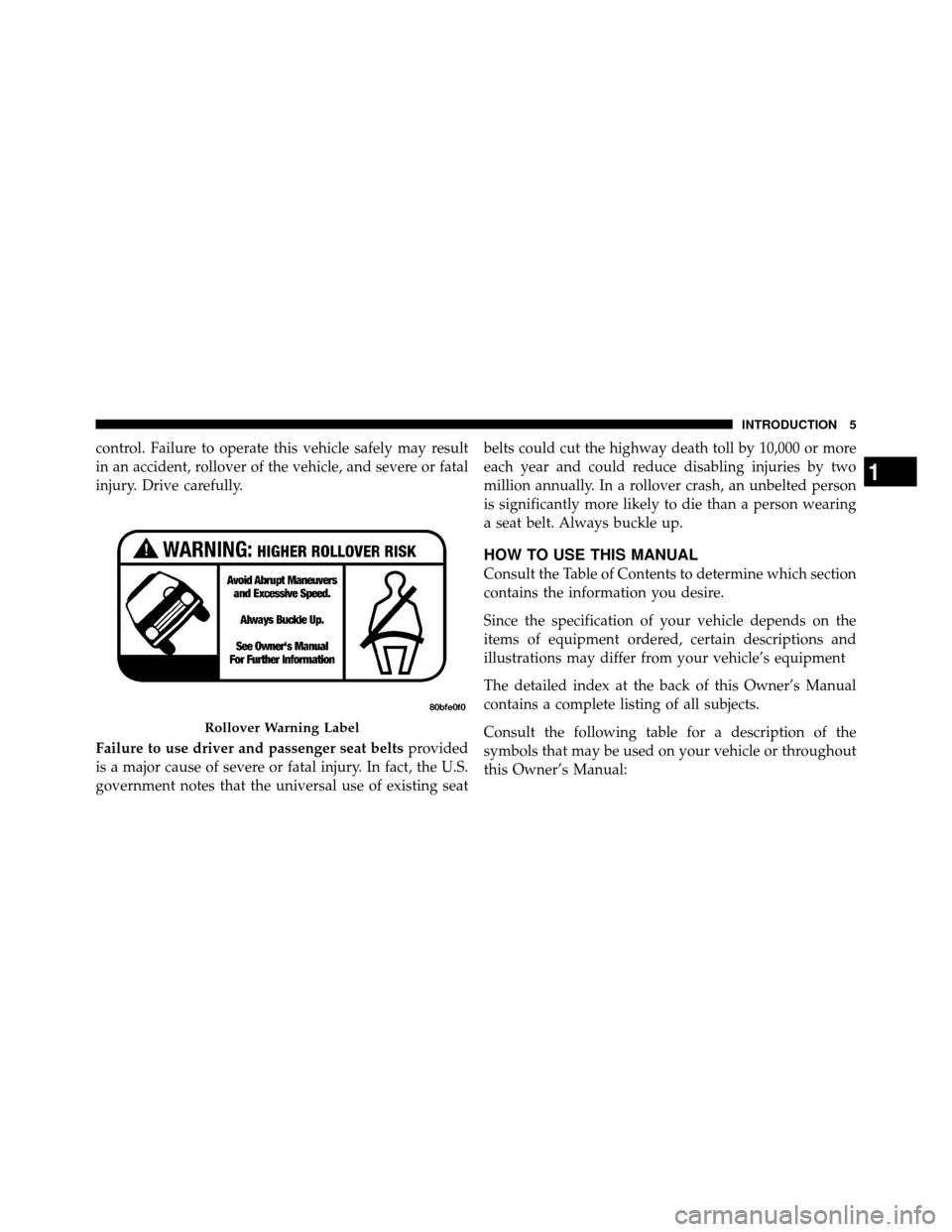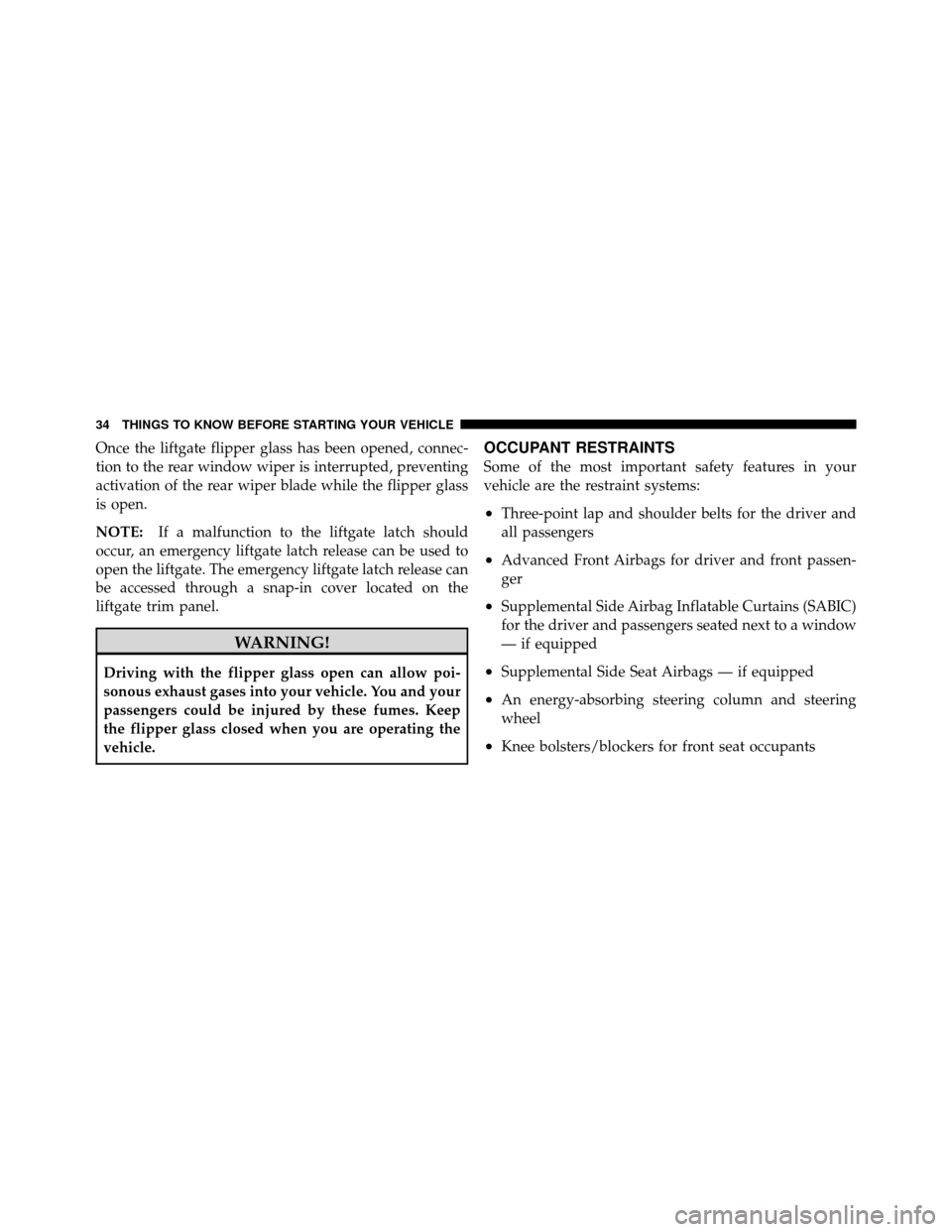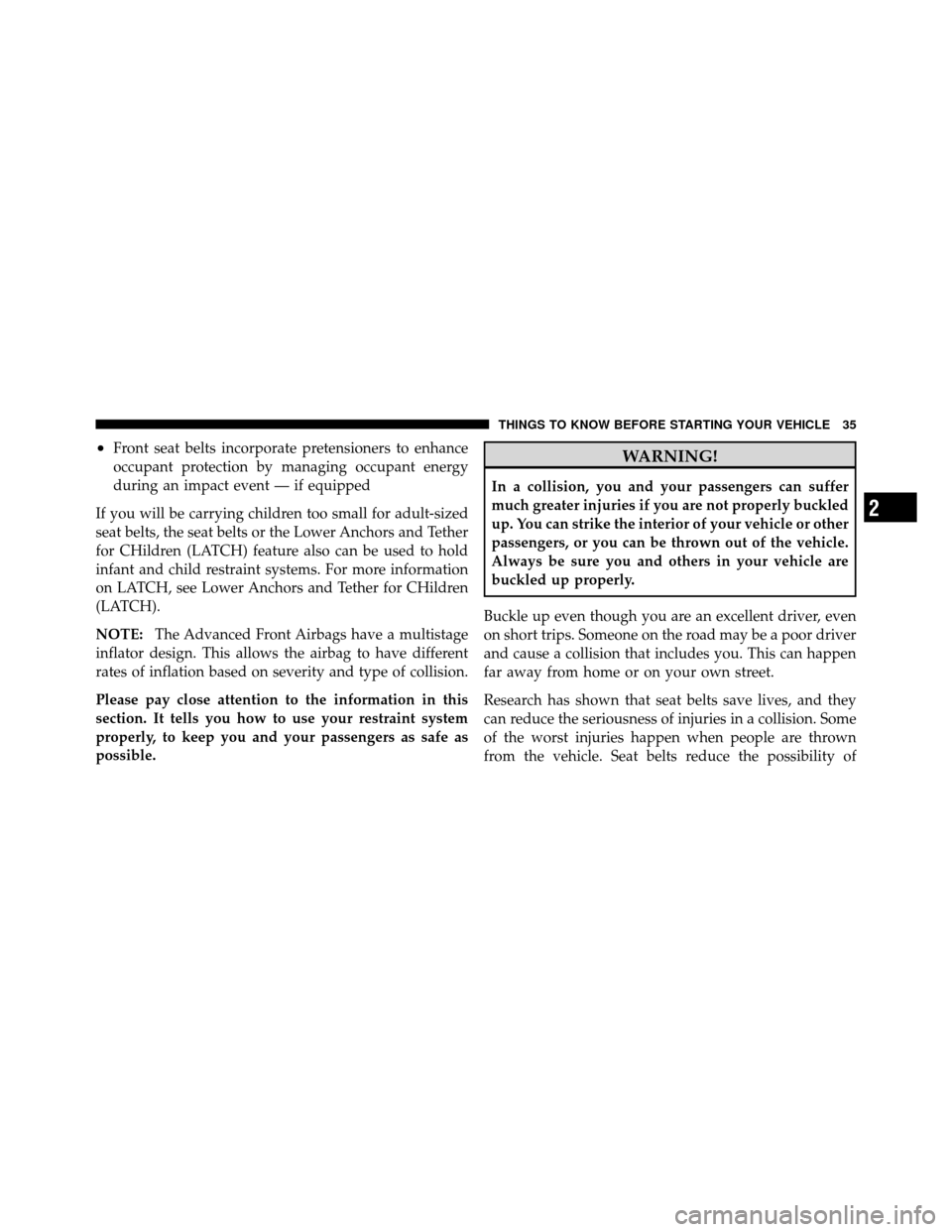Page 6 of 407

control. Failure to operate this vehicle safely may result
in an accident, rollover of the vehicle, and severe or fatal
injury. Drive carefully.
Failure to use driver and passenger seat beltsprovided
is a major cause of severe or fatal injury. In fact, the U.S.
government notes that the universal use of existing seat belts could cut the highway death toll by 10,000 or more
each year and could reduce disabling injuries by two
million annually. In a rollover crash, an unbelted person
is significantly more likely to die than a person wearing
a seat belt. Always buckle up.
HOW TO USE THIS MANUAL
Consult the Table of Contents to determine which section
contains the information you desire.
Since the specification of your vehicle depends on the
items of equipment ordered, certain descriptions and
illustrations may differ from your vehicle’s equipment
The detailed index at the back of this Owner’s Manual
contains a complete listing of all subjects.
Consult the following table for a description of the
symbols that may be used on your vehicle or throughout
this Owner’s Manual:
Rollover Warning Label
1
INTRODUCTION 5
Page 11 of 407

▫Remote Open Window Feature — If
Equipped ........................... 21
▫ Using The Panic Alarm ................. 22
▫ Programming Additional Transmitters ...... 22
▫ Transmitter Battery Replacement .......... 22
▫ General Information ................... 23
� Remote Starting System — If Equipped ....... 24
▫ How To Use Remote Start ............... 24
� Door Locks ........................... 26
▫ Manual Door Locks ................... 26
▫ Power Door Locks .................... 27
▫ Child Protection Door Lock .............. 28
� Windows ............................ 29 ▫
Power Windows ...................... 29
▫ Wind Buffeting ....................... 32
� Liftgate ............................. 32
▫ Liftgate Flipper Glass .................. 33
� Occupant Restraints ..................... 34
▫ Lap/Shoulder Belts .................... 36
▫ Lap/Shoulder Belt Operating Instructions .... 37
▫ Adjustable Upper Shoulder Belt Anchorage . . . 41
▫ Energy Management Feature ............. 41
▫ Automatic Locking Retractors (ALR) Mode
— If Equipped ....................... 42
▫ Seat Belt Pretensioners — If Equipped ...... 43
▫ Enhanced Seat Belt Use Reminder System
(BeltAlert�) ......................... 43
10 THINGS TO KNOW BEFORE STARTING YOUR VEHICLE
Page 12 of 407
▫Seat Belts And Pregnant Women .......... 44
▫ Seat Belt Extender ..................... 44
▫ Supplemental Restraint Systems (SRS) —
Airbags ............................ 45
▫ Advanced Front Airbag Features .......... 47
▫ Airbag Deployment Sensors And Controls . . . 51
▫ Event Data Recorder (EDR) .............. 58
▫ Child Restraints ...................... 60 �
Engine Break-In Recommendations .......... 70
� Safety Tips ........................... 71
▫ Transporting Passengers ................ 71
▫ Exhaust Gas ......................... 71
▫ Safety Checks You Should Make Inside The
Vehicle ............................. 72
▫ Periodic Safety Checks You Should Make
Outside The Vehicle ................... 73
2
THINGS TO KNOW BEFORE STARTING YOUR VEHICLE 11
Page 35 of 407

Once the liftgate flipper glass has been opened, connec-
tion to the rear window wiper is interrupted, preventing
activation of the rear wiper blade while the flipper glass
is open.
NOTE:If a malfunction to the liftgate latch should
occur, an emergency liftgate latch release can be used to
open the liftgate. The emergency liftgate latch release can
be accessed through a snap-in cover located on the
liftgate trim panel.
WARNING!
Driving with the flipper glass open can allow poi-
sonous exhaust gases into your vehicle. You and your
passengers could be injured by these fumes. Keep
the flipper glass closed when you are operating the
vehicle.
OCCUPANT RESTRAINTS
Some of the most important safety features in your
vehicle are the restraint systems:
•Three-point lap and shoulder belts for the driver and
all passengers
•Advanced Front Airbags for driver and front passen-
ger
•Supplemental Side Airbag Inflatable Curtains (SABIC)
for the driver and passengers seated next to a window
— if equipped
•Supplemental Side Seat Airbags — if equipped
•An energy-absorbing steering column and steering
wheel
•Knee bolsters/blockers for front seat occupants
34 THINGS TO KNOW BEFORE STARTING YOUR VEHICLE
Page 36 of 407

•Front seat belts incorporate pretensioners to enhance
occupant protection by managing occupant energy
during an impact event — if equipped
If you will be carrying children too small for adult-sized
seat belts, the seat belts or the Lower Anchors and Tether
for CHildren (LATCH) feature also can be used to hold
infant and child restraint systems. For more information
on LATCH, see Lower Anchors and Tether for CHildren
(LATCH).
NOTE: The Advanced Front Airbags have a multistage
inflator design. This allows the airbag to have different
rates of inflation based on severity and type of collision.
Please pay close attention to the information in this
section. It tells you how to use your restraint system
properly, to keep you and your passengers as safe as
possible.WARNING!
In a collision, you and your passengers can suffer
much greater injuries if you are not properly buckled
up. You can strike the interior of your vehicle or other
passengers, or you can be thrown out of the vehicle.
Always be sure you and others in your vehicle are
buckled up properly.
Buckle up even though you are an excellent driver, even
on short trips. Someone on the road may be a poor driver
and cause a collision that includes you. This can happen
far away from home or on your own street.
Research has shown that seat belts save lives, and they
can reduce the seriousness of injuries in a collision. Some
of the worst injuries happen when people are thrown
from the vehicle. Seat belts reduce the possibility of
2
THINGS TO KNOW BEFORE STARTING YOUR VEHICLE 35
Page 37 of 407

ejection and the risk of injury caused by striking the
inside of the vehicle.Everyone in a motor vehicle should
be belted at all times.
Lap/Shoulder Belts
All seating positions in your vehicle have combination
lap/shoulder belts. The belt webbing retractor is de-
signed to lock during very sudden stops or collisions.
This feature allows the shoulder part of the belt to move
freely with you under normal conditions. But in a colli-
sion, the belt will lock and reduce the risk of you striking
the inside of the vehicle or being thrown out.
WARNING!
•Wearing a seat belt incorrectly is dangerous. Seat
belts are designed to go around the large bones of
your body. These are the strongest parts of your
body and can take the forces of a collision the best.
Wearing your belt in the wrong place could make
your injuries in a collision much worse. You might
suffer internal injuries, or you could even slide out
of part of the belt. Follow these instructions to
wear your seat belt safely and to keep your pas-
sengers safe, too.
•Two people should never be belted into a single
seat belt. People belted together can crash into one
another in an accident, hurting one another badly.
Never use a lap/shoulder belt or a lap belt for more
than one person, no matter what their size.
(Continued)
36 THINGS TO KNOW BEFORE STARTING YOUR VEHICLE
Page 38 of 407
WARNING! (Continued)
•It is extremely dangerous to ride in a cargo area,
inside or outside of a vehicle. In a collision, people
riding in these areas are more likely to be seri-
ously injured or killed.
•Do not allow people to ride in any area of your
vehicle that is not equipped with seats and seat
belts.
•Be sure everyone in your vehicle is in a seat and
using a seat belt properly.
Lap/Shoulder Belt Operating Instructions
1. Enter the vehicle and close the door. Sit back and
adjust the seat.2. The seat belt latch plate is above the back of your seat.
Grasp the latch plate and pull out the belt. Slide the latch
plate up the webbing as far as necessary to make the belt
go around your lap.
Latch Plate
2
THINGS TO KNOW BEFORE STARTING YOUR VEHICLE 37
Page 39 of 407
3. When the belt is long enough to fit, insert the latch
plate into the buckle until you hear a “click.”WARNING!
•A belt that is buckled into the wrong buckle will
not protect you properly. The lap portion could
ride too high on your body, possibly causing
internal injuries. Always buckle your belt into the
buckle nearest you.
•A belt that is too loose will not protect you as well.
In a sudden stop you could move too far forward,
increasing the possibility of injury. Wear your seat
belt snugly.(Continued)
Latch Plate to Buckle
38 THINGS TO KNOW BEFORE STARTING YOUR VEHICLE